 | |
| Type | Private |
|---|---|
| Founded | 1996 |
| Headquarters | |
Area served | Worldwide |
| Website | vulcanair |


Vulcanair is an Italian aircraft manufacturer based in Casoria, near Naples. [1]
 | |
| Type | Private |
|---|---|
| Founded | 1996 |
| Headquarters | |
Area served | Worldwide |
| Website | vulcanair |


Vulcanair is an Italian aircraft manufacturer based in Casoria, near Naples. [1]
Partenavia was established in 1957 by Prof. Luigi Pascale and produced a quite large family of single-engined sport aircraft which eventually culminated with the successful twin-engined P.68 Victor and its derivatives. [2]
The Canguro was designed by aeronautical engineer Stelio Frati in the 1970s (first flight on December 30, 1978) for Siai Marchetti that, in 1981, developed the SF.600A version, with turboprop engine, retractable landing gear and cargo capability with lateral sliding door or hinged rear fuselage. Today just ten Canguro have been produced. [3]
Former spare parts producer Vulcanair set up a programme to produce a complete range of Italian designed twin-engined light transport aircraft. Vulcanair was founded in 1996 after purchasing all the assets, type design, trademarks and rights of the bankrupt Partenavia. In 1997, Vulcanair took over the SIAI-Marchetti SF.600 Canguro programme from Finmeccanica and later acquired Samanta, a Naples-based air-work operator with SF.600 and P.68 experience. Around 1998, Vulcanair took over Milan-based Aercosmos that had bought Partenavia Costruzioni Aeronautiche SpA from Alenia in 1993. [4]
Vulcanair was then in the position to revive the production of twin-engined aircraft ranging from the basic P.68C to the turbine-powered 8,000 lbs MTOW Canguro (possibly in a stretched version). [5] The Vulcanair P68C has been awarded by the Brazilian prestigious magazine "Aero Magazine" as best airplane 2010/2011 at the "XII Prêmio Aero Magazine de Aviação". [6]
Vulcanair's current products are based upon the designs of Stelio Frati (SF600A Canguro) and Luigi Pascale (P68 Series). The current production lineup is the P68C (in normally aspirated and turbocharged variants), the P68 Observer 2 (a surveillance orientated variant with a mainly Perspex cockpit, again in normally aspirated and turbocharged versions), a retractable undercarriage variant of the normally aspirated P68C, the P68R (or Vr), a Rolls-Royce RR250-B17C turboprop powered 11 seat AP68TP-600 A-Viator and the SF600A Canguro. [7]
Vulcanair is situated on 60,000 sq.m. of space at the Capodichino Airport in Naples, Italy. [1]


The SIAI-Marchetti SF.260 is an Italian light aircraft which has been commonly marketed as a military trainer and aerobatics aircraft.

The SIAI-Marchetti S.211 is a turbofan-powered military trainer aircraft designed and originally marketed by Italian aviation manufacturer SIAI-Marchetti.
SIAI-Marchetti was an Italian aircraft manufacturer primarily active during the interwar period.

The Partenavia P.68, now Vulcanair P68, is a light aircraft designed by Luigi Pascale and initially built by Italian company Partenavia. It made its first flight on 25 May 1970, its type certification was granted on 17 November 1971 and was transferred to Vulcanair in 1998. The original six-seat high-wing monoplane is powered by twin piston engines and is used for light transport and training. The P.68 Observer is an observation aircraft variant, and it was developed in a stretched, 10/11-seat twin turboprop derivative.
Stelio Frati was an Italian mechanical engineer and aeroplane designer. He graduated from the Politecnico di Milano as a mechanical engineer in 1943, participating in the design of the Aeronautica Lombarda AR radio-controlled wooden cantilever monoplane, powered by a single radial engine - a flying bomb/drone, flown for the first time the same year. After teaching aircraft design he became a freelance aircraft designer, being responsible for many well known aircraft designs. One of his best known designs is the Falco F8L.

The Lycoming O-540 is a family of air-cooled six-cylinder, horizontally opposed fixed-wing aircraft and helicopter engines of 541.5 cubic inches (8,874 cc) displacement, manufactured by Lycoming Engines. The engine is a six-cylinder version of the four-cylinder Lycoming O-360.

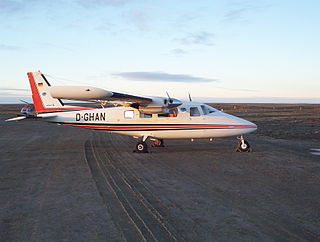
Partenavia Construzioni Aeronautiche was an Italian aircraft manufacturer that specialised in general aviation.
Aviamilano Costruzione Aeronautiche was an Italian aircraft manufacturer established in Milan in the early 1950s. It was the original manufacturer of Stelio Frati's Falco light aircraft, although when production did not run as smoothly as Frati liked, he took the design to Aeromere instead. Aviamilano's staple product was the Scricciolo trainer built for the Aero Club d'Italia from 1959 onwards. The firm's final product was another Frati design, the F.250, rights to which were sold to SIAI-Marchetti in 1964. The firm closed in 1968 after the death of its Managing Director and the rights to the few sailplanes then in production were bought by Caproni Vizzola.

The Waco Aircraft Company (WACO) was an aircraft manufacturer located in Troy, Ohio, United States. Between 1920 and 1947, the company produced a wide range of civilian biplanes.
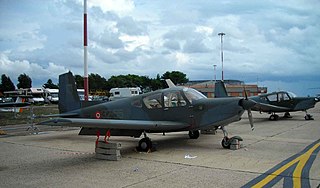
The SIAI-Marchetti S.205 is an Italian four-seat, single-engine, light airplane, manufactured by SIAI-Marchetti. The S.205 made its maiden flight in 1965. The Italian Air Force employs a version called S.208.
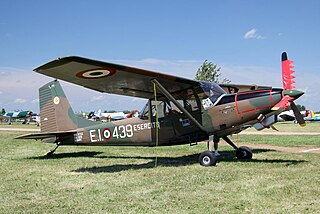
The SIAI-Marchetti SM.1019 is an Italian STOL liaison monoplane built by SIAI-Marchetti for the Italian Army. It is a turboprop-powered derivative of the Cessna O-1 Bird Dog.
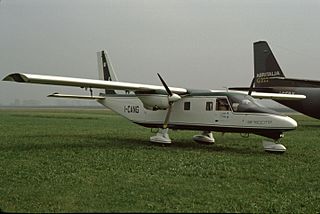
The Vulcanair SF.600 Canguro was a feederliner developed in Italy in the late 1970s. Despite a number of attempts to put the aircraft into series production, only a small number were ever built. The Canguro was a high-wing cantilever monoplane of conventional configuration with a fuselage of rectangular cross-section and a high-set tail. The tricycle undercarriage was not retractable, and its main units were carried on sponsons on the fuselage sides. SIAI Marchetti provided funding towards the construction of the prototype, and constructed this aircraft at the former Aviamilano plant. After flight testing proved positive, the type was put on sale, but failed to attract buyers in any number, even when the original piston engines were exchanged for turboprops and retractable undercarriage was offered as an option.
The Partenavia P.48 Astore was a 1950s Italian light aircraft built by Luigi Pascale and his brother in Naples before establishing Partenavia.
The SIAI-Marchetti S.700 Cormorano was an Italian proposal for a twin-engined amphibian based on the SF.600 Canguro.

The Pasotti F.9 Sparviero was a four-seat, low-wing touring aircraft, built in Italy in the 1950s. Designed by Stelio Frati, it was a single-engine version of his earlier twin-engined Airone. Only one was built.
The ECi O-320 is part of a family of normally aspirated, air-cooled, four-cylinder, direct-drive engines developed for certified and experimental aircraft. Its cylinders are arranged in horizontally opposed configuration and a displacement of 320 cubic inches (5.24 L). It is based on the Lycoming O-320 engine with ECi cylinder assemblies.

The Vulcanair VF600W Mission is an Italian single-engined utility transport, under development by Vulcanair of Casoria.
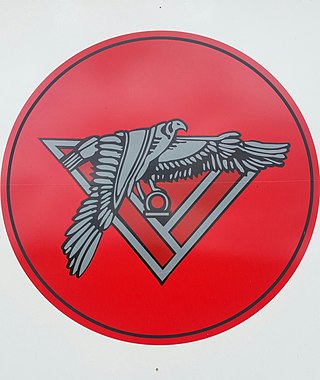
The 5th squadron is a training squadron which, together with the 9th squadron, forms the Basic Flying Training School of the Belgian Air Component.